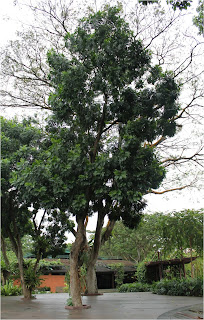Diospyros blancoi, or also known Butter Fruit, Velvet
Persimmon, Mabola and Velvet Apple, originated Philippines. It belongs to the
plant family of Ebenaceae.
An evergreen tree that grows up to 35
metres with black and furrowed trunk; it has dark-green leaves that are smooth
on the upper surface and hairy underneath. New leaves are showy, pale-green or
pink and silky-hairy. Male and female flowers are produced on separate trees as
Diospyros blancoi is a dioecious
plant species. Its creamy white and fragrant inflorescence has four petals
each, in clusters of 0.5 cm in diameter flowers for male and 1 cm in diameter for
female. Fruiting occurs two to four months after flowering, each of 5-10 cm wide
with velvety and brownish-orange skin which emanates a cheese-like odor.
The fruit’s flesh is used in meat dishes
and desserts (jellies and salads etc.). The bark is utilized for handicrafts
and furniture, especially for carvings. The tree is also cultivated for beliefs
in its medicinal properties; its leaves and bark treat coughs, fevers,
diarrhea, skin ailments, heart problems and wounds. Its fruit is a good source
of vitamins A, C, and minerals.
Look out for them at the Canoe Shed.
Pictures
(Diospyros blancoi found near the canoe shed)
(brownish-orange skin fruit)
















